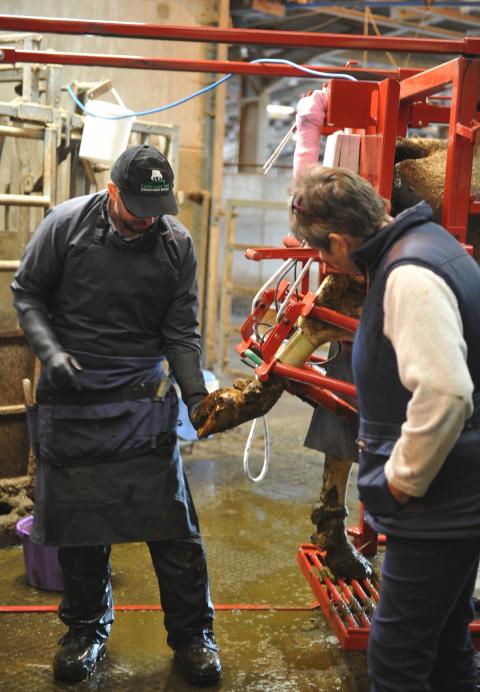23 May 2019
Treating the signs of lameness in a cow as an emergency by swiftly dealing with the problem can prevent irreversible damage to the affected foot, specialists in cattle lameness advise.
Lameness is a costly disease in Welsh dairy herds but many causes can be prevented, according to vets delivering expert advice at a Farming Connect Master Lameness course.
Independent veterinary consultants Dr Nick Bell and Sara Pedersen said farmers must be prepared to respond quickly to the lame cow.
“The damage to the foot is usually irreversible, affecting the bone and soft tissues, making lameness an emergency,’’ said Dr Bell.
If treated successfully at the bruising stage, virtually all sole ulcers and some other hoof lesions can be prevented.
“If we successfully treat cows with new digital dermatitis lesions then we can prevent further spread and minimise infection pressure,’’ Dr Bell explained.
Foot shape can be corrected to prevent some claw lesions, and with regular foot checks this can be done in the early stages.
“What is important at foot checks is to avoid over-trimming. We generally follow the five-step method,’’ said Dr Bell.
- Correct the toe length – start with the inside hind claw or outside front claw and measure the appropriate length from where the claw horn goes hard; trim the excess sole from the toe to effectively steepen the foot angle and tip the cow forward onto her toe. Spare the heel and the side walls.
- Match the other claw for length and balance, again sparing the heel and side walls.
- Dish out the site of the sole ulcer deep and wide. Create slurry clearance space between the claws.
- For corrective trimming for lesions causing lameness, create a heel height difference between the healthy and painful claw; apply a block and/or trim down the heel on the back two thirds of an outside hind claw if diseased.
- Remove loose horn and sharp ridges – loose horn around a sole ulcer, white line or necrotic lesions needs careful removal. Remove fissures of heel erosion.
Prompt treatment and trimming will help alleviate lameness but prevention by eliminating risk factors should be the goal.
Ms Pedersen said that changes in the foot around calving are one of the key risk factors for sole ulcers along with poor cow comfort resulting in long standing times; sole ulcers can be thought of as ‘Stand up’ disease.
The target lying time for a housed cow is 12-14 hours per day. The latest research shows they are only achieving an average of 10.
Once time needed for eating, drinking and socialising is taken into account, this only allows two hours in a cow’s day for milking. For any length of time that milking extends beyond two hours, lying times will be compromised, Ms Pedersen warned.
She cited the example of one farmer client with excellent housing facilities but with each milking taking five hours. “Even though the farm had invested extensively in providing comfortable cubicles, sole ulcers were a big problem because there simply wasn’t sufficient time for the cows to spend lying down.’’
Heat stress is another lameness trigger – a common problem in dairy herds during last summer’s hot weather – so steps should be taken to keep cows cool if hot conditions are repeated this year; this includes providing plenty of cool water on the exit to the parlour and making sure cows are not cramped in collecting yards at milking as this reduces their ability to cool off.
Cubicle design is another area that should not be overlooked – improvements can often be made without major investment, Ms Pedersen suggested. “There aren’t many cubicle sheds on farms where adjustments can’t be made, the more comfortable cubicles are the longer the lying times.’’
Master Lameness was held on the college farm at Coleg Gwent, Usk, and facilitated by Imogen Ward, Farming Connect Dairy Technical Officer.
“Lameness is one of the biggest welfare issues on UK dairy farms. If farmers can improve on their incidence of lameness it is good for their cows and for their businesses.’’
Farmers attending the course agreed. Carys Jones, who helps to run her family’s Larchwood Holsteins herd at Magor, said in the fully-housed system with high yielding cows, foot health had to be constantly managed.
“It has been a good experience to learn about the gold standards of maintaining foot health,’’ she said.
Josh James, who produces milk from 200 Holsteins at Redwick, said lameness wasn’t a major issue in his herd but added: “Until you achieve zero lameness there are always things you can do to improve, to help get to that point I will be putting into practice some of the excellent advice we have been given on this course.’’
Funding for the project has been provided by the Welsh Government’s Rural Communities Rural Development Programme 2014-2020.

